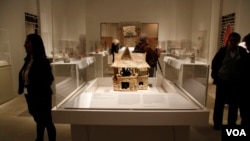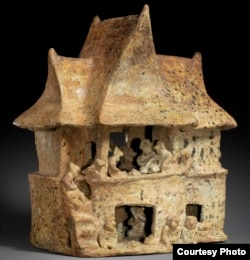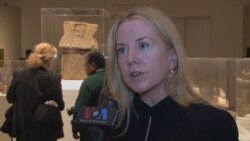Historic and extraordinary architectural models from the ancient Americas go on public display in late October at the Metropolitan Museum of Art in New York. The exhibit is a major achievement in bringing together architectural models from the great civilizations that existed in what is now Central and South America during the Middle Ages and earlier.
From the first millennium B.C. until the arrival of Europeans in the 16th century, artists in the ancient Americas created small-scale architectural models to be placed in the tombs of important individuals. These works in stone, ceramic, wood and metal range from highly abstracted, minimalist representations of temples and houses to elaborate architectural complexes populated with figures.
These miniature structures were critical components in funerary practice and belief in afterlife, and they convey a rich sense of ancient ritual and the daily lives of the Aztecs, the Incas and their predecessors.
In some of more detailed pieces in this exhibit, there are examples of how the people feasted; how the deceased, in many cases, were given places of honor; and what life was like.
Pre-Inca palace
Exhibit curator Joanne Pillsbury told VOA about the centerpiece of the exhibition, a spectacular wooden model that depicts part of a pre-Inca palace at Chan Chan, capital of the Chimu Empire. This great Andean desert city, located on a low plateau above the Pacific Ocean, flourished for some 500 years before the Chimu were conquered by the Incas around 1470.
This model has never been seen in the United States. Pillsbury said, “It was an exceptional loan from Peru’s Ministry of Culture. It was excavated 20 years ago at Huaca de la Luna.”
She added, “It may represent something that we have only heard about from Spanish historical sources, the 16th century and later, which is the idea that the Inca did not bury the royal dead — that they kept their royal mummies around, and these royal mummies could still have their palaces. They were given new clothes, they were invited to feasts, they could get married.”
This palace model with figures is considered a part of the Chimu culture and was created sometime between 1440 and 1665 A.D. The archaeologists who discovered the Palace Model are Santiago Uceda and Ricardo Morales. They came to New York for this extraordinary event.
The exhibit contains many varieties of vessels, ornamental pieces and exceptional ceramic work. Perhaps the finest example of a house model known from the Nayarit culture of West Mexico greets the visitor as he or she walks into the exhibit space. The two-story Nayarit house depicts a great feast. On the upper level, 16 figures, including pairs of men and women with their arms wrapped around one another, gather around vessels filled with food and pulque, a fermented beverage.
Tombs below
Because the Nayarit buried their dead under their houses, the lower rooms have been identified as tombs. Similar to the feasts themselves, the models reinforce the connection between the living and the dead, the sacred and the civic.
For nearly 3,000 years, ballgames played a central role in the religious and political life of communities throughout Mesoamerica. Pillsbury believes the extraordinary model in the exhibit is a lively depiction of one of the earliest ballgames in the world.
“As you know," she said, "rubber came from Mexico, ancient Mexico, from the Veracruz gulf coast, and was not known in Europe until the 16th century." The ball court model, she said, features an eye-shaped ball court with markers on it, plus the players.
"We think the game probably was a little like soccer, in that it seems like they couldn’t use their hands," Pillsbury said. "And so we see one of the players going down and hitting the ball with his hip and we see the court lined with spectators, some with arms around each other.”
In all, there are about 60 items, including architectural models, figurines, vessels, boxes, bottles, textiles, clothing and decorative hangings, that make up this “Design for Eternity: Architectural Models from Ancient America.”
WATCH: Exhibit Curator Joanne Pillsbury Speaks With VOA.



















